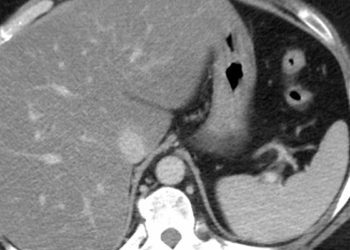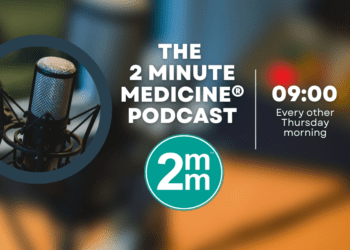Targeted thyroid hormone delivery reduces off-target effects [PreClinical]
1. Delivery of a hybridized form of glucagon and the thyroid hormone T3 (G/T3) improved signs of metabolic syndromes including dyslipidemia and nonalcoholic steatohepatitis (NASH).
2. Unlike treatment with T3 alone, G/T3 improved pathological signs without causing adverse effects on cardiac function and bone integrity.
Evidence Rating Level: 1 (Excellent)
Study Rundown: Dysfunction of systems that maintain lipid homeostasis is often the key accelerator of conditions like non-alcoholic fatty liver disease. Though thyroid hormones are important regulators of lipid metabolism, their therapeutic potential has been attenuated by potent side effects. In this work, researchers developed a glucagon-conjugated form of T3 that targeted delivery of T3 to the liver, and corrected dyslipidemia and NASH while preventing off-target effects.
The hybridized G/T3 compound specifically led to T3 accumulation in the liver due to greater expression of the glucagon receptor GCGR in hepatic tissue relative to other tissues. The efficacy of G/T3 in the liver was evaluated in a mouse model of diet-induced obesity (DIO), where G/T3 treatment effectively lowered liver cholesterol levels. Concurrently, G/T3 significantly reversed dyslipidemia. G/T3 was also tested in a mouse model of NASH, where fat accumulation in the liver is a hallmark of the disease. In mice with NASH, G/T3 decreased lipid accumulation and fibrosis in the liver and reduced serum cholesterol levels and alanine aminotransferase (ALT) concentrations. Importantly, therapeutic levels of G/T3 did not induce off-target effects whereas T3 alone led to changes in heart function and bone density.
This work provides strong evidence that targeted delivery of T3 via hybridization to glucagon can be a potent treatment option for metabolic syndrome and associated diseases. More detailed future work should demonstrate the efficacy of long-term G/T3 treatment and the benefits of using G/T3 over currently available thyroid hormone mimetics.
Click to read the study in Cell
Relevant Reading: Targeting thyroid hormone receptor-β agonists to the liver reduces cholesterol and triglycerides and improves the therapeutic index
In-Depth [animal study]: To measure G/T3 tissue specificity, a fluorescent version of G/T3 was subcutaneously (s.c.) injected (100nmol/kg) into C57Bl6j mice 6 hours before organ harvesting. Fluorescence was greatest in the liver compared to the pancreas, adipose tissue, and heart. RT-PCR gene expression analysis of Gcgr in the liver, adipose tissue, and heart was also completed and demonstrated highest levels in the liver. In Gcgr-/- mice, liver T3 levels were measured after daily s.c. injection for 7 days. Gcgr-/- mice showed little change in T3 levels whereas wild-type mice developed a >40-fold T3 increase.
In the DIO model, mice were maintained on a high-fat, high-cholesterol diet. Mice (n=8) were treated with daily s.c. injections of G/T3 (100nmol/kg) for 14 days. Liver samples demonstrated significant reduction in cholesterol when compared to vehicle treatment. Blood samples also reflected significant reduction in plasma cholesterol (p<0.001) and triglycerides (p<0.05). In the NASH model, mice were maintained on a choline-deficient, high-fat diet for 6 months before treatment. Livers were analyzed using immunohistochemistry after 21 days of daily injections. G/T3 treatment produced a 30% reduction in lipid-positive area of tissue sections (p<0.001) and eliminated any indication of collagen deposition indicated by trichrome staining. Blood tests revealed a 3-fold reduction in cholesterol (p<0.001) and significant decrease in ALT, suggesting recovery of liver damage.
Finally, cardiac function and bone health were evaluated in mice following daily s.c. G/T3 injections (100nmol/kg) for 28 days. While T3 alone significantly decreased heart rate, fraction shortening, and ejection fraction (p<0.01), G/T3 demonstrated no impact on these parameters. Similarly, T3 significantly diminished bone density of lumbar vertebrae L5 as measured by microCT whereas G/T3 had no effect.
Image: PD
©2016 2 Minute Medicine, Inc. All rights reserved. No works may be reproduced without expressed written consent from 2 Minute Medicine, Inc. Inquire about licensing here. No article should be construed as medical advice and is not intended as such by the authors or by 2 Minute Medicine, Inc.







